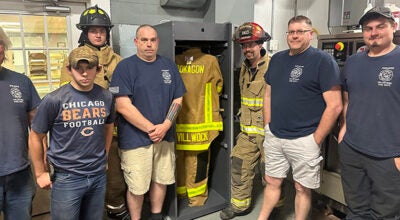Depot lights not about the holidays
Published 9:59 pm Tuesday, November 27, 2012
In three years, Light Up the Depot has gone from strings lining eave troughs to a 1,600-bulb display that illuminates the chimney.
Since the $8,000 project turns on in November, many probably regard it as holiday lights, but according to Ron Leatz, who spearheaded the fundraising drive, “It has nothing to do with Christmas.”
The lights give Dowagiac’s 110-year old train station a brighter future than it seemed to have when plans for its dedication were scrapped by a tax dispute.
That’s why the depot was finally dedicated with great fanfare on Nov. 7, 2011.
Leatz said lights coincide with daylight savings time, which is why they burn until mid-March.
As keynote speaker Steve Arseneau, museum director, explained at Light Up the Depot, as construction neared completion in the spring of 1902, city fathers hoped Michigan Central Railroad would improve parkland along the tracks from Park Place to Commercial Street.
The May 15, 1902, Daily News felt the time was right for Dowagiac to “transform the park from a lounging place for hobos to a thing of beauty,” but in June the city Board of Review socked the railroad with a $16,000 tax assessment, “which did not sit well,” Arseneau said.
The depot figures in much local history, from the 1854 Orphan Train arrival and Smithsonian Art Trains to presidential whistle stops by Theodore Roosevelt, Woodrow Wilson and Gerald Ford. Bill Clinton was supposed to stop. Thomas Dewey did, but lost to Harry Truman.
Three depots have occupied the site — the first, in 1849; the second, 1872, used for 29 years; and 1902, built for $10,000.
“It’s not an exaggeration to say Dowagiac would not exist without the railroad” arriving in 1848, Arseneau said, “if Michigan Central Railroad kept its Detroit to Chicago line on its original plan to go to St. Joseph. Instead, (MCRR) changed course down into this valley that became Dowagiac and the monetary influence of land speculators,” for whom nearby Beeson, Chesboro and Robinson streets were named on the original plat.
Five years later, Philo Beckwith came to town, built Round Oak stoves for train stations.
Dowagiac bustled with taverns, hotels and shops along Front Street instead of Main Street.
Four trains stop daily at the station, an economic engine which Leatz is always lobbying to rescue through ridership since moving to his wife’s hometown in 2005.
He’s waiting to see if Amtrak adding four trains for Thanksgiving was successful enough to be extended for Christmas.
He attended a Kalamazoo meeting where a Grand Rapids consultant was evaluating Albion, Dowagiac and Bangor stops.
Each stop eliminated can shave 15 minutes off travel time between Chicago and Detroit with 110-mph trains.
Leatz said Bangor won the summer because more resorters ride trains to South Haven than do those who drive to Sister Lakes.
A question he gets often is how the city spends on electricity for its depot.
“We bought the best LED lights we could find,” he said. “It only costs 20 to 25 cents a day.”






